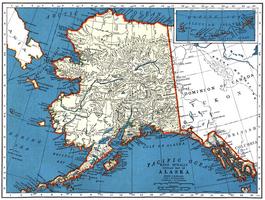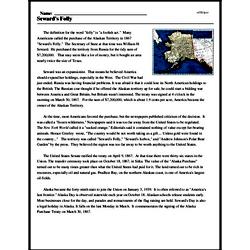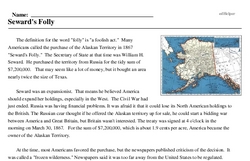Seward's Folly
The definition for the word "folly" is "a foolish act." Many Americans called the purchase of the Alaskan Territory in 1867 "Seward's Folly." The Secretary of State at that time was William H. Seward. He purchased the territory from Russia for the tidy sum of $7,200,000. That may seem like a lot of money, but it bought an area nearly twice the size of Texas.
Seward was an expansionist. That means he believed America should expand her holdings, especially in the West. The Civil War had just ended. Russia was having financial problems. It was afraid it that it could lose its North American holdings to the British. The Russian czar thought if he offered the Alaskan territory up for sale, he could start a bidding war between America and Great Britain, but Britain wasn't interested. The treaty was signed at 4 o'clock in the morning on March 30, 1867. For the sum of $7,200,000, which is about 1.9 cents per acre, America became the owner of the Alaskan Territory.
At the time, most Americans favored the purchase, but the newspapers published criticism of the decision. It was called a "frozen wilderness." Newspapers said it was too far away from the United States to be regulated. The New York World called it a "sucked orange." Editorials said it contained nothing of value except fur-bearing animals. Horace Greeley wrote, "The country would be not worth taking as a gift.... Unless gold were found in the country..." The territory was called "Seward's Folly," "Seward's Icebox," and "Andrew Johnson's Polar Bear Garden" by the press. They believed the region was too far away to be worth anything to the United States.




